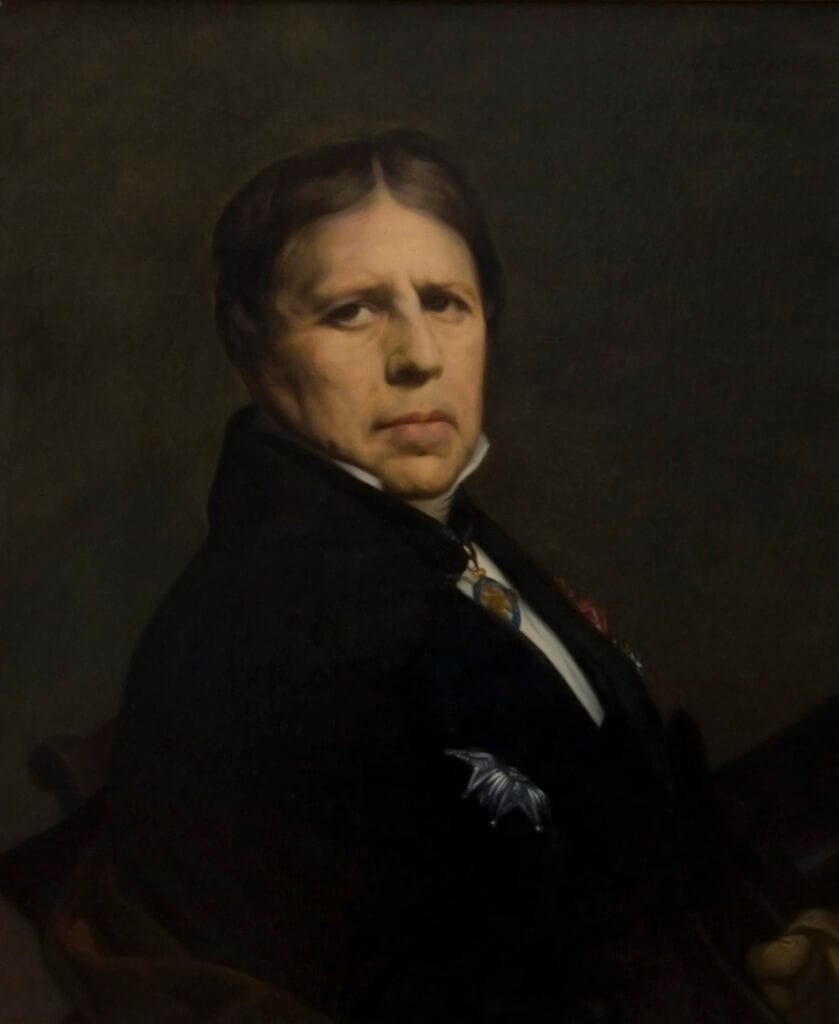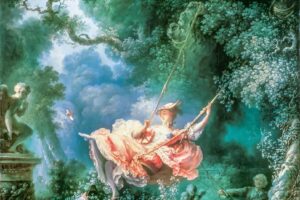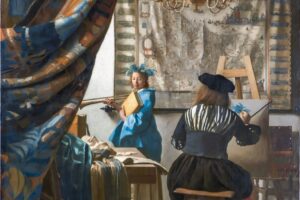Jean-Auguste-Dominique Ingres, 1814
A Moment of Arrangement, Not of Joy
In this rich and formal setting, Ingres paints not love’s passion—but duty’s demand. The scene is historical, but deeply human. We are in the presence of Raphael, the great Renaissance artist, Cardinal Bibbiena, a powerful man of the Church, and the Cardinal’s niece, destined for marriage.
Yet what should be a joyful engagement feels strangely solemn. Why?
Raphael’s Reluctant Heart
The young man in green, with long hair and a fur-lined cloak, is Raphael himself. He does not lean toward his bride. His face is calm, perhaps respectful, but distant. This is no eager lover. This is an artist, maybe thinking of someone else—or of art itself, the true love of his life.
History tells us that Raphael was indeed promised to Maria Bibbiena, the Cardinal’s niece, but delayed the marriage for years. Some say he was secretly in love with another woman. Others say he never wanted to marry at all.
Ingres captures that hesitation. Raphael’s posture is polite but cool. He does not reach for Maria’s hand. Instead, the Cardinal guides the moment—like a director on a stage.
The Cardinal’s Command
At the center, in a bright red robe, sits Cardinal Bibbiena. He is the authority here, clothed in ecclesiastical power and surrounded by dark wood and deep shadows. He gestures with assurance, pointing toward the bride, signaling approval—or instruction.
His presence dominates the composition. It’s not a moment of shared affection. It’s a transaction, a union arranged, perhaps for favor, perhaps for alliance. Duty stands taller than emotion.
The Bride in Velvet and Silence
On the right, Maria Bibbiena stands quietly in crimson velvet. Her hands rest gently on her chest, fingers folded, gaze lowered. There is shyness here—or sadness.
She wears pearls in her hair, a symbol of purity, and a golden sash. She is richly dressed, but her emotions are veiled. We do not know what she feels, only that she stands apart, with her eyes cast down, outside the current of connection.
Behind the Curtain: A Shadowed Watcher
In the background, a faint figure peeks from behind a curtain. This shadowy witness adds mystery—perhaps a servant, perhaps symbolic of the hidden tensions behind arranged unions. The open curtain is like a glimpse into a private world now made public.
Ingres’ Message: When Art Meets Obligation
Jean-Auguste-Dominique Ingres was a master of precision and grace. Every fold of cloth, every gesture, every glance is carefully shaped. Yet what makes this painting unforgettable is what lies beneath the beauty.
Here, Ingres shows us the quiet drama of arranged marriage—the contrast between public duty and private feeling, between social expectation and personal longing.
The Irony of Love Delayed
In truth, Raphael never married Maria Bibbiena. She died before the wedding ever took place. He remained devoted to his art and possibly to a secret muse.
And so, this painting is not a celebration—but a moment suspended. A story of what was planned… but never was.
About Artist

Jean-Auguste-Dominique Ingres (1780–1867) was a French painter who, along with his mentor Jacques-Louis David, became a leading figure of Neoclassicism. However, while David’s style was about moral clarity and stoic heroism, Ingres was more concerned with grace, line, and form. He was a champion of the academic tradition and believed that drawing (dessin) was the most important element of painting. His work is known for its exquisite precision, smooth surfaces, and a unique, idealized approach to the human form
Artistic Style and Rivalry
Ingres’s art can be seen as a bridge between Neoclassicism and early Romanticism. He revered the works of Raphael and the classical masters, striving for a sense of timeless perfection in his own art. His paintings often feature elongated figures, particularly in his female nudes, which demonstrate his willingness to distort anatomy for the sake of aesthetic beauty and an elegant line. This unique style put him in direct opposition to the more emotionally charged and painterly works of the Romantic artist Eugène Delacroix, creating one of the great rivalries in 19th-century French art.
Notable Works
Ingres’s long and prolific career produced a wide range of portraits, nudes, and historical paintings.
- The Apotheosis of Homer (1827): This monumental painting is a masterpiece of Neoclassical art. It shows the ancient Greek poet Homer enthroned as a divine figure, with famous artists and thinkers from history gathered at his feet in homage. The painting is a clear statement on the timeless perfection of classical art and a tribute to artistic greatness.
- The Betrothal of Raphael (1814): This elegant work depicts the Renaissance master Raphael and his fiancée. It is a tribute to Ingres’s hero, Raphael, and is characterized by its classical composition, graceful figures, and a sense of refined harmony.
- La Grande Odalisque (1814): One of his most famous nudes, this painting showcases Ingres’s signature style. The figure’s elongated back and elegant, sinuous lines are a deliberate distortion for aesthetic effect, making the painting a landmark of idealized form.
- The Valpinçon Bather (1808): An early and intimate nude, this painting is celebrated for its soft light, simple composition, and the subject’s vulnerable pose. The smooth, porcelain-like skin and the precise rendering of the fabrics are a testament to his technical skill.
- Madame Moitessier (1856): This is one of Ingres’s greatest portraits. It depicts a wealthy Parisian woman in a lavish, almost sculptural pose. The painting is celebrated for its meticulous detail, from the intricate lacework to the reflection in the mirror, and is a perfect example of his later, more refined portraiture.



